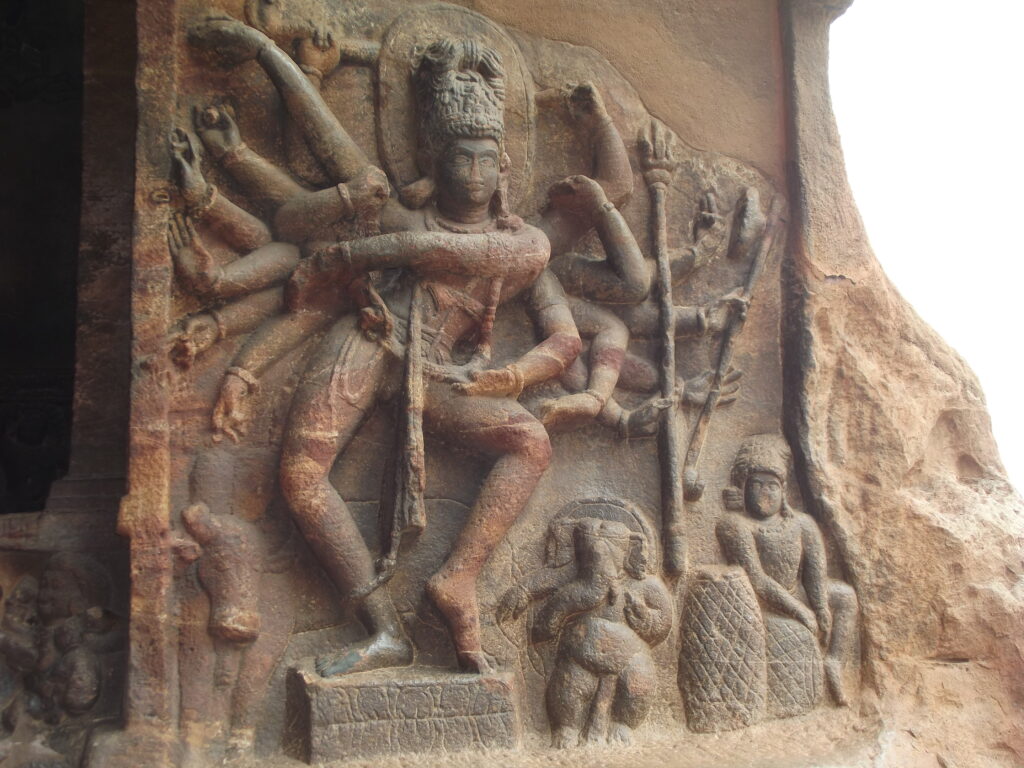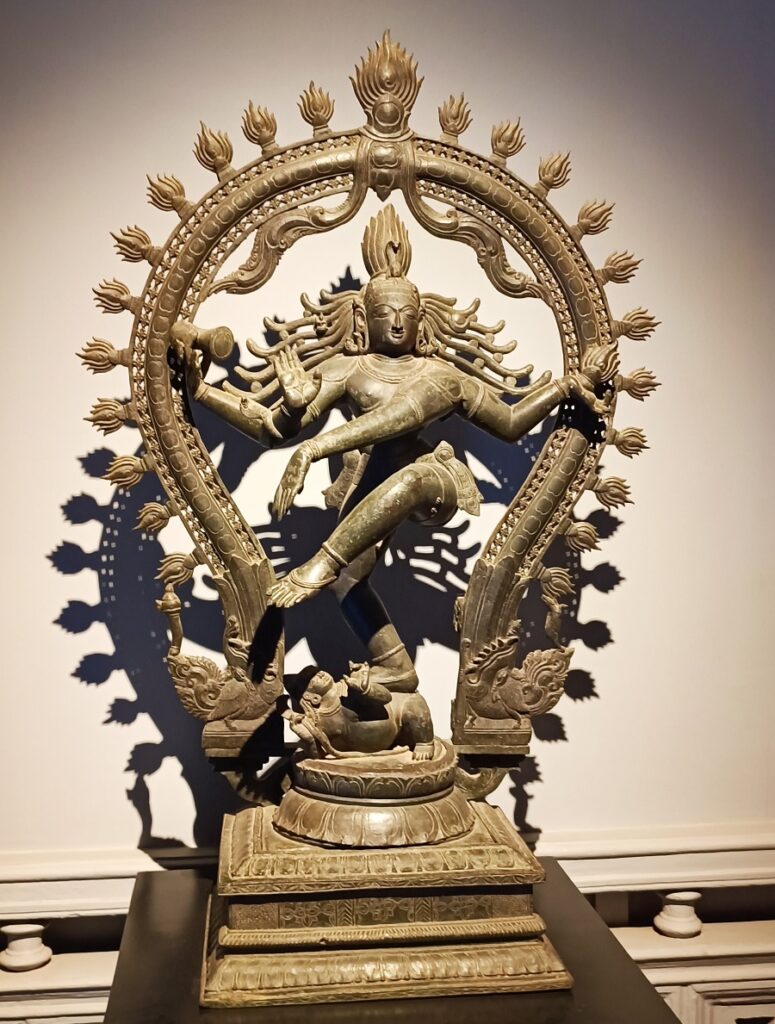
The Nataraja statue made from ‘Astadhatu’ (eight metals), installed at Bharat Mandapam in New Delhi is world’s tallest idol. | Photo Credit: ANIIn recently concluded G20 summit at Bharat Mandapam in Delhi, the tall statue of Nataraja caught a lot of eyes. It was an magnificent effort at displaying our incredible culture to the world. The 28 ft high bronze sculpture of the divine cosmic dancer has put forward a very strong statement. And on this note, I thought it would be appropriate to learn a few things about Nataraja.
What does Nataraja Mean ?
Sculpture of Nataraja, Avanibhajana Pallaveshwaram temple , Seeyamangalam, Tiruvannamalai district in Tamil Nadu

The word Nataraja is a Sanskrit term, from नट Nata meaning “act, drama, dance” and राज Raja meaning “king, lord”; it can be roughly translated as Lord of the dance or King of the dance. The name hence can be translated to “Lord of Dancers” or “King of Actors”. Nataraja is alternatively mentioned as Nateshwar, Natesh and Nrityeshwara in some texts. Nataraja is a depiction of the Shiva as the divine cosmic dancer. The dance is called as the tandava. The pose and artwork are described in many Hindu texts such as the Tevaram and Thiruvasagam in Tamil and the Amshumadagama and Uttarakamika agama in Sanskrit.
The two most common forms of Shiva’s dance are the Lasya (the gentle form of dance), associated with the creation of the world, and the Tandava (the vigorous form of dance), associated with the destruction of weary worldviews—weary perspectives and lifestyles. In essence, the Lasya and the Tandava are just two aspects of Shiva’s nature; for he destroys in order to create, tearing down to build again. Lasya is often referred as the dance innovated and performed by the goddess Parvati, described to be gentle and graceful. Described in the Natya Shastra, the feminine Lasya danced by Parvati is contrasted by the masculine Tandava dance of her consort, Shiva. Some stories also suggest that the dance Lasya was taught to Shiva by Parvati herself.
The depiction of Nataraja
There are two opinions about where the first classical form of the depiction appears. Some historians believe that it first appears in a pillar of rock cut temple at Seeyamangalam – Avanibhajana Pallaveshwaram Temple constructed by a Pallava King Mahendravarman I in 6th century CE. While some other believe that the earliest depiction appears in the archaeological site at Asanapat village in Odisha, which includes an inscription, and is dated to about the 6th century CE. The Asanapat inscription also mentions a Shiva temple in the Saivacaryas kingdom. Stone reliefs depicting the classical form of Nataraja are found in numerous cave temples of India, such as at the Ellora Caves (Maharashtra), the Elephanta Caves, and the Badami Caves (Karnataka), by around the 6th century. Literary evidences shows that the bronze representation of Shiva’s ananda-tandava appeared first in the Pallava period between 7th century and mid-9th centuries CE. Nataraja was worshipped at Chidambaram during the Pallava period with underlying philosophical concepts of cosmic cycles of creation and destruction, which is also found in Tamil saint Manikkavacakar’s Thiruvasagam.
Archaeological discoveries have yielded a red Nataraja sandstone statue, from 9th to 10th century from Ujjain. Similarly, Nataraja artwork has been found in archaeological sites in the Himalayan region such as Kashmir, albeit in with somewhat different dance pose and iconography, such as just two arms or with eight arms. Around the 10th century, it emerged in Tamil Nadu in its mature and best-known expression in Chola bronzes, of various heights. Nataraja reliefs are found in historic settings in many parts of South East Asia such as Ankor Wat, and in Bali, Cambodia, and central Asia. The dancing Shiva became a part of Chola era processions and religious festivals, a practice that continued thereafter.
The depiction and iconography

The depiction of Nataraja at Badami cave No 1, Badami, Dist Bagalkot, Karnataka. 6th Century (Early Chalukya era).
The sculpture is symbolic of Shiva as the lord of dance and dramatic arts, with its style and proportions made according to Hindu texts on arts. It typically shows Shiva dancing in one of the Natya Shastra poses, holding Agni (fire) in his left back hand, the front hand in gajahasta (elephant hand) or dandahasta (stick hand) mudra, the front right hand with a wrapped snake that is in abhaya mudra while pointing to a Sutra text, and the back hand holding a musical instrument, usually a Udukai His body, fingers, ankles, neck, face, head, ear lobes and dress are shown decorated with symbolic items, which vary with historic period and region. He is surrounded by a ring of flames, standing on a lotus pedestal, lifting his left leg (or in rare cases, the right leg) and balancing / trampling upon a demon shown as a dwarf (Apasmara or Muyalaka) who symbolizes spiritual ignorance. The dynamism of the energetic dance is depicted with the whirling hair which spread out in thin strands as a fan behind his head. The details in the Nataraja artwork have been variously interpreted by Indian scholars since the 12th century for its symbolic meaning and theological essence.
The symbolism
Like every sculpture in Hinduism, the Nataraja idol is also full of lot of symbolisms. Nataraja dances within a circular arch of flames (prabha mandala), which symbolically represent the cosmic fire that creates everything and consumes everything, in cyclic existence or cycle of life. The upper right hand holds a small drum shaped like an hourglass that is called a ḍamaru in Sanskrit. A specific hand gesture (mudra) called ḍamaru-hasta is used to hold the drum. It symbolizes rhythm and time. The upper left hand contains Agni or fire, which signifies forces of creation and destruction. The opposing concepts show the counterpoise nature of life. A cobra uncoils from his lower right forearm, while his palm shows the Abhaya mudra, suggesting not to fear nearby evil, as well as evil and ignorance surrounding the devotee as he or she follows the righteousness of dharma. The lower left hand is bent downwards at the wrist with the palm facing inward. We also note that this arm crosses Naṭarāja’s chest, concealing his heart from view. It represents tirodhāna, which means “occlusion, concealment.” The dwarf upon whom Nataraja dances is the demon Apasmara purusha that symbolises the demonic evil and ignorance over which the sacred dance of Shiva gives victory. The slightly smiling face of Shiva represents his calmness despite being immersed in the contrasting forces of universe and his energetic dance.
Chola Bronze Sculpture

Bronze sculpture of Natraja from Tamilnadu, currently displayed at Chhatrapati Shivaji Maharaj Vaastu Sangrahakaya, Mumbai
The period of the imperial Cholas (c. 850 CE – 1250 CE) in South India was an age of continuous improvement and refinement of art and architecture. They utilised the wealth earned through their extensive conquests in building long-lasting stone temples and exquisite bronze sculptures. Among the existing specimens in the various museums of the world and in the temples of South India, may be seen many fine figures of Siva in various forms accompanied by his consort Parvati and the other gods, demigods and goddesses of the Saivaite pantheon, Vishnu and his consort Lakshmi, the Nayanmars, other Saiva saints and many more. Though conforming generally to the iconographic conventions established by long tradition, the sculptor could also exercise his imagination within the boundaries of the canonical Hindu iconography and worked in greater freedom during the eleventh and the twelfth centuries. As a result, the sculptures and bronzes show classic grace, grandeur and taste. The best example of this can be seen in the form of Nataraja, the Divine Dancer.